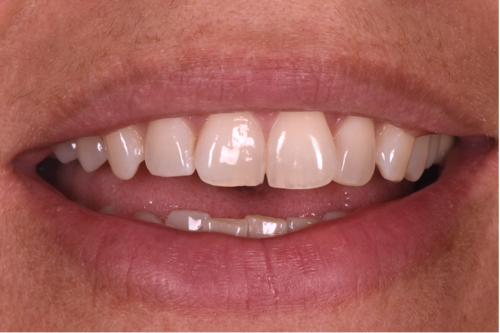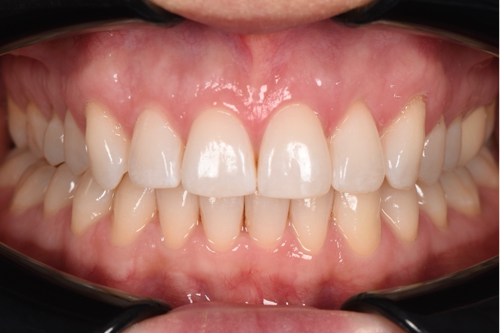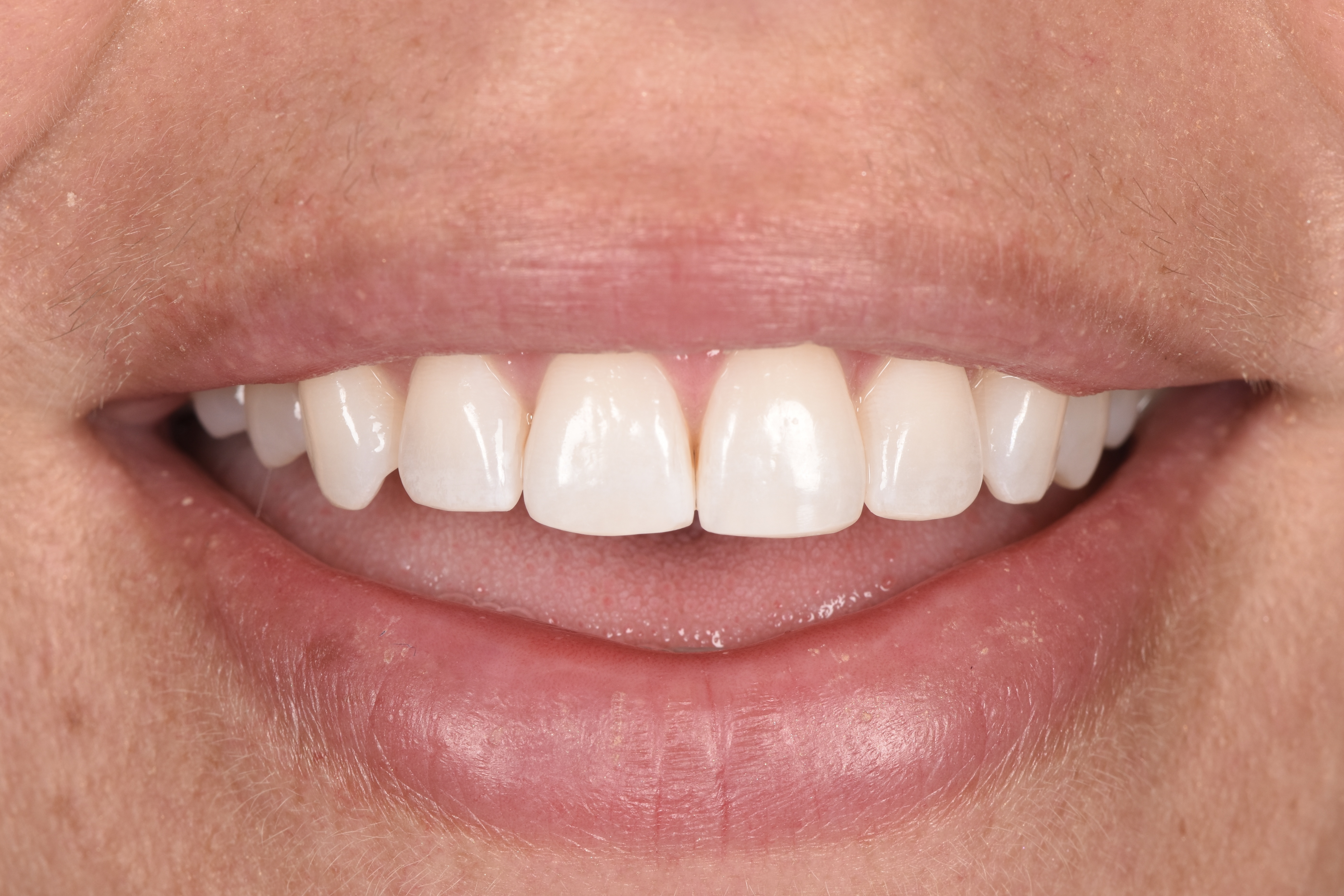A female patient presented with concerns about the appearance of her teeth, particularly the rotated upper incisors, and was seeking a solution that would restore her confidence to smile.
The patient was new to the practice, and a comprehensive assessment of her dentition was conducted. Mild crowding was present in the upper and lower arches, and the upper incisors were rotated mesiopalatally – the UL1 was rotated by 22 degrees and the UR1 by 23 degrees, respectively.
The molars, canines and incisors on the right and left side demonstrated mild Class II relationships, and the dentition was minimally restored. The patient was experiencing a restricted envelope of function, which was exacerbating tooth wear. Following X-rays, an orthopantomogram and bitewings, no bone loss was detected, making her an ideal candidate for orthodontic treatment.
 Figure 1. Mild crowding in the upper and lower arches with rotated incisors, smile view.
Figure 1. Mild crowding in the upper and lower arches with rotated incisors, smile view.

Figures 2 and 3. Pre-treatment, open anterior view and closed anterior view.

Figures 4 and 5. Pre-treatment in the upper arch with mesiopalatally rotated incisors, occlusal view and pre-treatment in the lower arch.

Figures 6 and 7. Pre-treatment right and left lateral view.
A unique opportunity
A range of treatment options were presented to the patient. The use of a fixed brace and clear aligners were proposed, with the use of 3D visual aids to improve the patient’s understanding of the treatment process.
Clear aligners were preferred for their aesthetic benefit, especially as this case would not require attachments. This was possible with SureSmile aligners, which allowed for customised trimlines. Where other systems scallop around the teeth, I was able to opt for a solution that had a straightened trimline of one mm, eliminating the need for attachments while ensuring safe, controlled and predictable movement.
An analysis for treatment was devised with the help of the Spacewize+ digital space calculator and SureSmile software, though the initial proposal was not thought to be ideal by both myself and my mentor from IAS Academy, Claudia Waddell. It required excessive proclination of the teeth and round-tripping, and my mentor advised that we amend the use of interproximal reduction (IPR) and predictive proximal reduction (PPR). In the revised proposal, these were to not be performed on overlapping contacts and only enacted once the patient’s teeth were untangled.
As determined by our treatment planning software, IPR was to be carried out between the UL1 and UL2, and UL2 and UL3, each 0.3 mm. Through the LR3 to the LL3, 0.3 mm of IPR was once again prescribed in each interdental space. Between the LR3 and LR4, and LL3 and LL4, 0.2 mm was planned for.
Both arches were to be aligned simultaneously. Sixteen aligners were planned for the upper arch, and another 18 for the lower. The patient was also advised that the use of refiners may be necessary.
I did not plan for the use of composite bonding once treatment had ended, but the patient was made aware that this option was available to her should it be judged necessary.

Figures 8 and 9. Fitting of the first aligner with a 1mm trimline, closed and open anterior view.
Carrying out care
The fitting appointment was far quicker than normal, as no attachments had to be placed. This created plenty of time to provide instructions for effective oral hygiene measures and proper use and maintenance of her aligners. By wearing the aligners for at least 22 hours a day and changing the devices every two weeks, there was a greater chance of the predicted progression being achieved.
Frequent appointments were made to ensure that the case was tracked as it should and that any potential issues could be spotted before they developed. I shared the outcome of each appointment with my IAS Academy mentor, and she advised on the miniscule details that would make the greatest difference throughout treatment.
This was especially helpful when carrying out IPR and PPR as treatment progressed. The mesiopalatal rotations of the teeth had contributed to an uneven wear pattern. The bases were wider than the necks of the teeth, and without the use of IPR and PPR, black triangles in the interproximal spaces may have developed over time. Sometimes, this is unavoidable, but effective planning and monitoring throughout treatment can minimise the effect.
A soft flex disc was used to carry out the PPR at the first appointment and throughout the rest of the patient’s care, with callipers used for precision. In some cases, a reduced amount of IPR was performed where PPR was judged to have a greater effect. For example, an intervention of 0.2 mm may be split between 0.1 mm of IPR, and 0.1 mm of PPR that de-triangulates the teeth, resulting in a seamless smile.
Overall, treatment was tracked as expected throughout this case. My mentor even went as far as superimposing images of the patient’s dentition during treatment onto the corresponding stage of the 3D planning software. They matched up well, and allowed for the judgement of any necessary IPR, whilst helping me decide upon any advice that I needed to give to a patient. For example, I realised I needed to reiterate the importance of orthodontic aids, such as chewies, throughout treatment.
The patient undertook a two-week course of Boutique Whitening to achieve a brighter tooth shade and create a uniform, brilliant smile.
No considerable departures were made from my overall treatment plan, and the final result was attained with only minor contouring needed. I once again owe this to a comprehensive treatment plan that was considered with great care with the help of my IAS Academy Mentor.

Figure 10. Post-treatment in the upper arch, occlusal view.

Figures 11 and 12. Post-treatment of the upper and lower arch, anterior view.

Figure 13. Post-treatment, anterior view.
On reflection
This was my first clear aligner case that did not require attachments, and I was delighted with the functional and aesthetic result. The patient was equally happy and noted that the process was easier than she had anticipated. She was thrilled with the newly crafted smile, noting that the change was very visible in photos. Friends she hadn’t seen in some time now complimented her teeth.
I gave her two removable retainers to wear nightly, which the patient preferred over fixed solutions. I discussed the potential for relapse, and the patient recognised their role in this outcome. I have since seen the patient at three, six and nine-month intervals post-treatment, and the results have held.
This case has allowed me to further consider the importance of an effective treatment plan, and refine my recognition of the need for IPR and PPR in a variety of situations. With support from my mentor, I feel better equipped to treat similar cases in the future, and provide patients with a smile that they adore.

Figure 14. Post-treatment, smile view.


